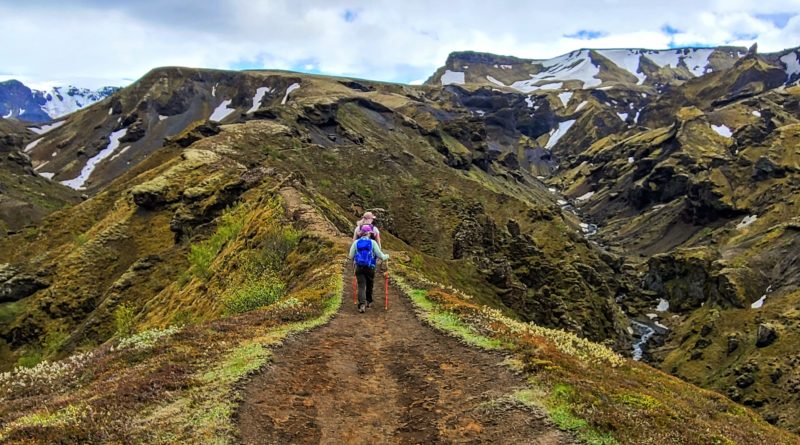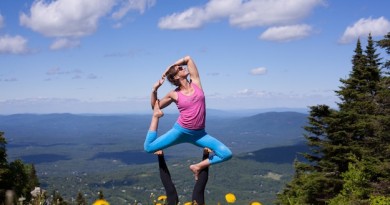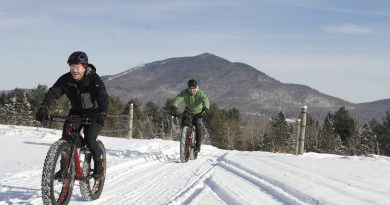Chasing Iceland’s Vanishing Ice
A curious thing happened during my Covid quarantine. Vermonters were posting incredible photos from…Iceland. There was the friend hiking to see bright orange lava bubbling out of an active volcano. Another friend chilling in geothermal hot springs. A couple who backpacked the world famous Laugavegur Trail (jealous). Bikepackers pushing their bikes through rivers (no thanks). And the friends skiing long snowfields down to the ocean (insanely jealous). Even my next door neighbor has been to Iceland three times. Just because it’s such a cool place. And cheap to get there (see Details sidebar).
Something else made me feel like I shouldn’t delay my pilgrimage to Iceland: the land of fire and ice is melting. One tenth of Iceland is covered in glaciers, but they are receding by about three football fields per year or more In 2019, Iceland held a symbolic funeral for Okjökull, its first glacier lost to climate change. Some 400 other glaciers are also at risk, and Iceland may be ice free in the next 100-200 years.
Now is the time to chase ice.
An easy five hour flight from Boston delivered my wife Sue and I to Reykjavik, Iceland’s cosmopolitan capital. We arrived at midnight on a Friday in May. The city was bathed in golden light as if it were late afternoon in Vermont. Iceland is the land of the midnight sun, with sunlight round the clock in the summer. The charming European city with colorfully painted buildings transforms on weekends into one of Europe’s hippest and liveliest party scenes. We strolled around after midnight among revelers packed shoulder to shoulder as if it were a festival on a summer afternoon.
We spent our first day in Iceland traveling the famous Golden Circle, a roughly 200-mile round trip drive from Reykjavik that features three impressive stops: Thingvellir, where we hiked down between the upturned edges of the Eurasian and North American tectonic plates to see the site of the world’s first (and hopefully not last) democratic parliament; Geysir, where the ground was steaming and erupting; and Gullfoss, a thunderous three-level waterfall that plunges over 100 feet into a narrow chasm and explodes into mist. This was a breathtaking intro to Iceland’s spectacular natural attractions.
The next morning we drove out of Reykjavik to South Iceland. In front of us, the horizon was crowned by the vast white Vatnajokull (pronounced vat-na-yokul) icecap, our ultimate destination. This is the largest icecap in Europe and one of the fastest melting glaciers in the world. As we drove, the landscape around us– to use an oft-repeated descriptor in Iceland – was other-worldly. Everywhere we looked, waterfalls spilled down mountainsides, some wispy and vanishing into midair, others thundering down in torrents. The landscape alternated between incandescent green and black lava fields, the aftermath of Iceland’s many volcanic eruptions.
Hollywood has long been eager to capitalize on Iceland’s other-worldliness. Numerous films depicting faraway lands have been shot here, including Star Wars, two James Bond movies, Batman Begins, Game of Thrones, Tomb Raider, and the Secret Life of Walter Mitty, to name just a few.
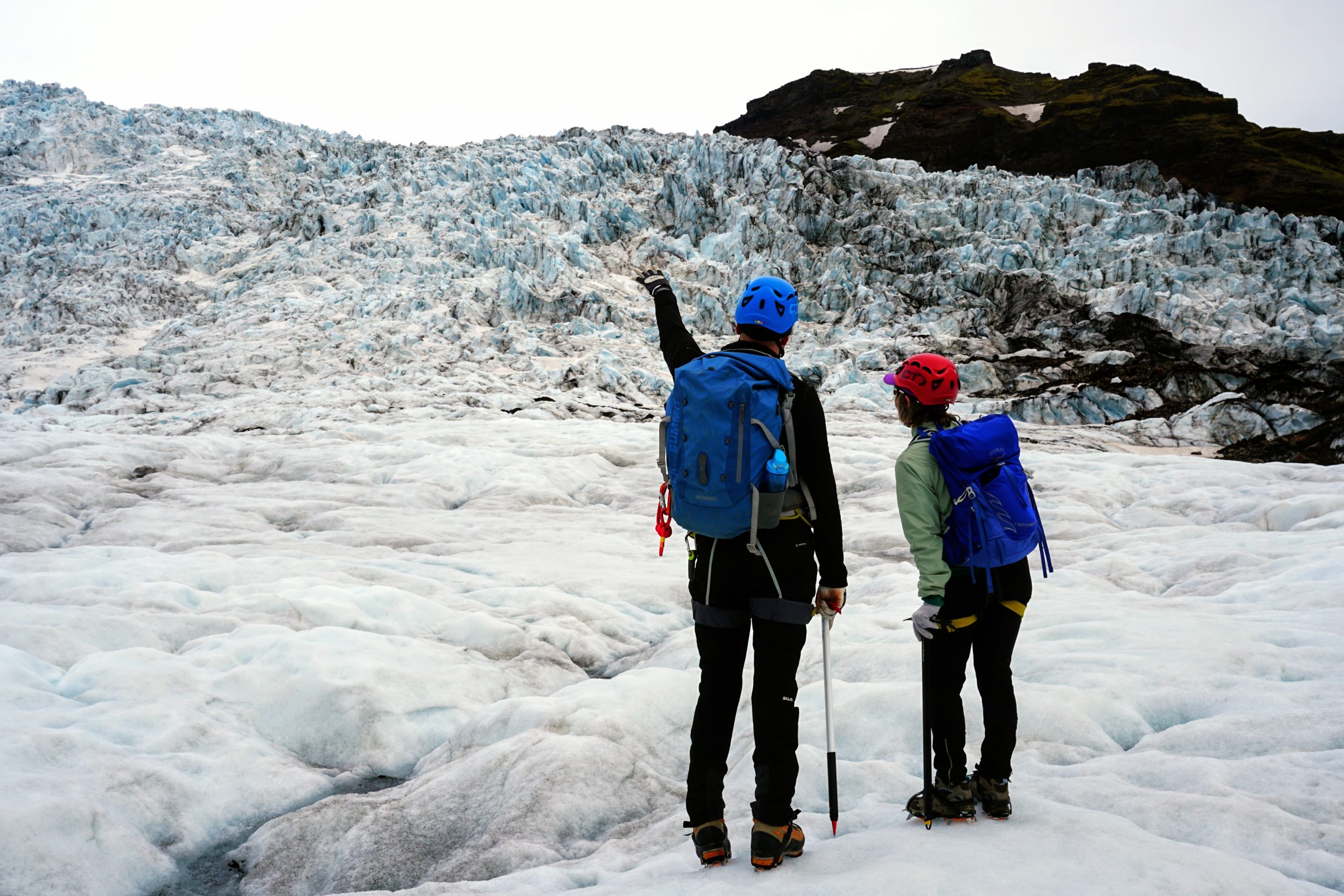
We connected with Asgeir Ingi, a veteran guide with Hidden Iceland, to venture up onto the Falljokull Glacier, an outlet glacier that flows off the 3,000 square mile Vatnajokull Icecap. The icecap, which ranges up to 1 km in thickness, sits like a plug atop seven volcanoes, three of which are active.
We donned crampons, ice axes and harnesses and followed Asgeir around a lake to the edge of the glacier. “Ten years ago when I was starting to take people out to the glaciers, we would only walk a few steps from our vehicle and we would be on the ice,” Asgeir explained. By contrast, we walked about 20 minutes to reach the edge of the glacier. “That’s because it is receding so fast,” he says. Evidence of the recession can be seen in the growing glacial lake that used to be covered in several meters of ice.
Our crampons bit into the glacier with a distinctive crunch. We marched up into a stunning frozen landscape. The ice constantly changed color and texture. It included swirls of black ash, evidence of past volcanic eruptions. We closely followed Asgeir has he wove through the crevasses. I couldn’t take my eyes off the cacophony of ice that towered over our heads. Turquoise ice blocks leaned precariously in front of us and yawning crevasses vanished far beneath our feet. The glacier felt alive, groaning and cracking as we navigated our way upward.
Asgeir motioned with his axe and stopped to make sense of this jumble of ice. Falljokull means “falling glacier,” a reference to its steepness. “We are right in the icefall where the glacier has descended from the icecap and turns into an outlet glacier, where it cracks open and forms crevasses,” he said, pointing to the slots that threatened to swallow us. “Then the entire ice mass travels down to a plateau where it gets squished back together and the crevasses close up.” It continues downhill and “opens and closes like an accordion.”
We climbed as far into the icefall as was safe, then slowly descended the glacier. We were engulfed by a world of color and sound that was both magical and menacing to our little human procession. Asgeir pointed to the polished rock walls that were recently exposed by the receding ice. “The authorities are closing down many of the glaciers that we have been going to previously because of the danger of rock falls. That is happening because the glaciers in Iceland are receding at abnormally fast rates, which leaves a big part of the mountain unstable. We’re also experiencing more floods and mudslides because of this.”
Asgeir said wistfully, “It’s a privilege to be able to see the glaciers before they leave.”
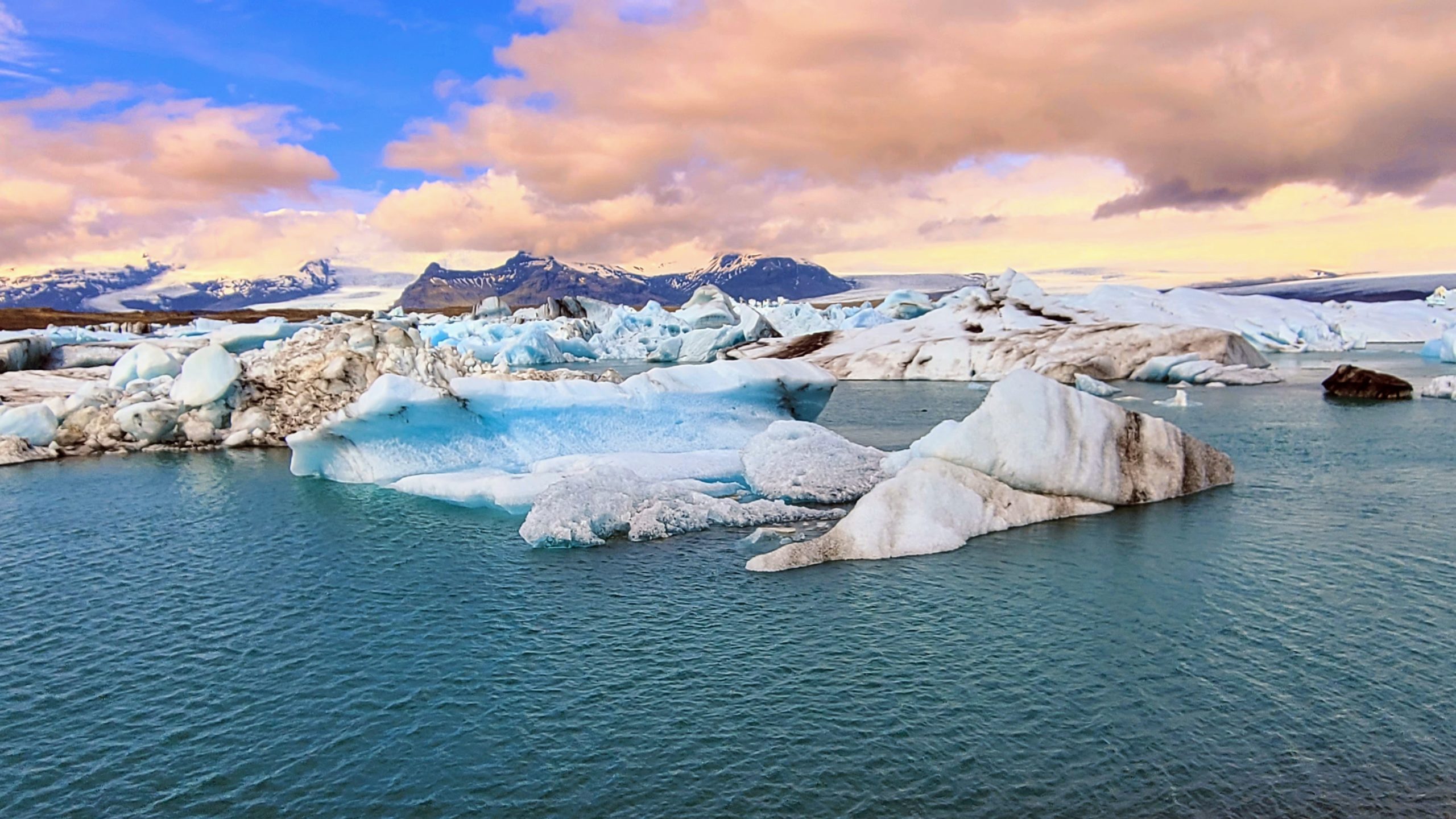
What is perilous is also beautiful. After descending the glacier, we drove a short distance to Jokulsarlon Lagoon. Icebergs glistened and floated in the luminous blue lagoon created by the melting of the Vatnajokull Glacier, which was calving off before our eyes. The lagoon is only about 90 years old and is now 25 square km, growing as the glacier recedes some 500 meters per year. We follow the lagoon as it made its way to the nearby ocean. The icebergs break up and pieces sparkled on black lava sand known as Diamond Beach. They appeared as alluring as gemstones in a jeweler’s showcase.
Reflecting on the dramatic changes that we witnessed, Asgeir said, “You are experiencing a country still in formation. You’re seeing these extraordinary waterfalls, but then half an hour later you are walking on a glacier, and then in another half hour, you’re walking on a black sand beach or a green mossy field as far as your eyes can see. And if you’re if you’re really lucky,” he added with a twinkle in his eye, “you could experience a volcanic eruption.”
Arctic Against Climate Change
The Arctic is warming four times as fast as the global average, and parts of the Arctic experienced their hottest June on record in 2022. Iceland is considered part of the Arctic region, though most of its mainland is just south of the Arctic Circle. The consequences of a melting Arctic will impact the world in the form of rising sea levels, warming seas, the decline of boreal forests, hotter summers and heavier rainfall, to name a few effects.
Iceland is a leader in clean energy. The island nation has committed to a 55% reduction in greenhouse gas emissions by 2030 compared to 1990 levels, and carbon neutrality by 2040. Geothermal energy heats more than 90% of homes in Iceland and comprises more than half of the country’s energy mix. The country is also innovating by injecting carbon dioxide deep into the earth and converting it into rock.
Tourism has created a climate conundrum. Iceland (pop. 376,000) had the highest per capita greenhouse gas emissions of any European country in 2021, partly a result of the millions of tourists who fly to Iceland to enjoy its natural wonders.
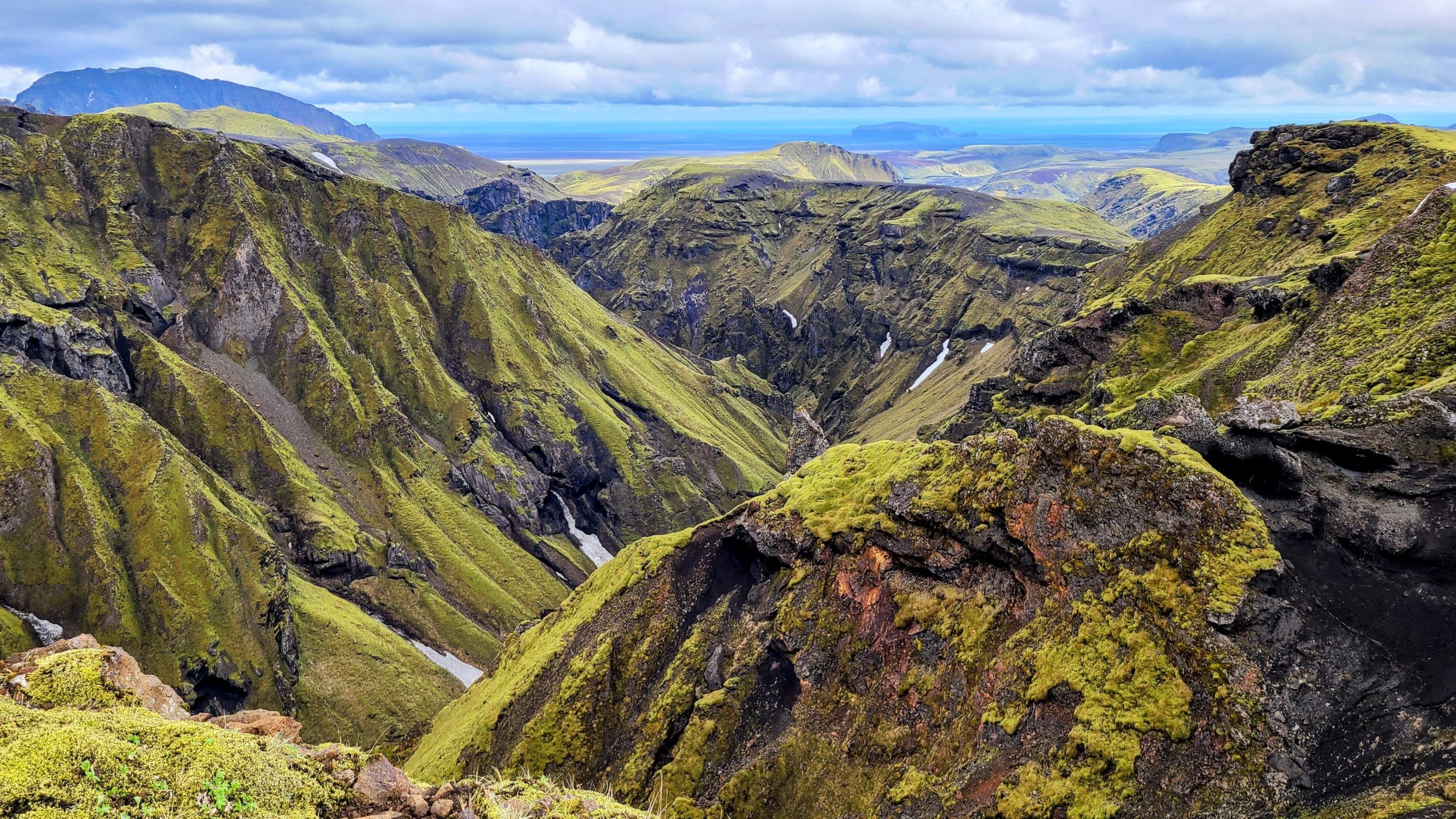
Higher Hiking
Iceland is hiking heaven (see sidebar). We planned to do Iceland’s most famous day hike, the 15-mile Fimmvörðuháls Trail, which threads between two massive glaciers and passes by 26 waterfalls. We learned that the higher elevations of the trail were still under snow, so we opted to hike the part of the route that was accessible (the trail is best hiked from late June to early September) .
After staying overnight at a friendly lodge operated by Midgard Adventure, we headed out with our guide Hildur Kristjansdottir, a co-owner of Midgard. She pulled up in our ride, a balloon-tire Super Jeep capable of fording rivers that would ferry us to the trailhead. Our hike would take us close to Eyjafjallajokull (pronounced aya-fatla-yokul), the volcano that erupted in 2010 and brought European air travel to a standstill for a week. As one of the most volcanically active places in the world, Iceland has an outsized impact on the global climate.
We hiked the Fimmvörðuháls as it ascended a lush valley. Waterfalls tumbled down the hillsides, which alternated between hues of gold and green. We soon broke out onto an open plateau and took in the awe-inspiring site of the glaciers that crown the volcanoes. Hildur broke out a flask of hot tea and cookies and sat down for an impromptu picnic. We had a front row perch from where we watched the glaciers calve enormous blocks of ice that tumbled to the valley floor.
I asked Hildur if it was unsettling to live in the shadow of the volcanoes. Her take surprised me. “We do not walk around in our everyday life worrying about the volcanoes,” said the mountain guide and mother. “Climate change is a lot, lot bigger worry for us.”
Why? I pressed her. “We’re just used to the volcanoes. We have a good infrastructure with how we built the houses and how we monitor the volcanoes and we have evacuation plans. They do pop from time to time, but we always figure it out. There’s not been a catastrophic eruption here in a really long time. So this is our choice.”
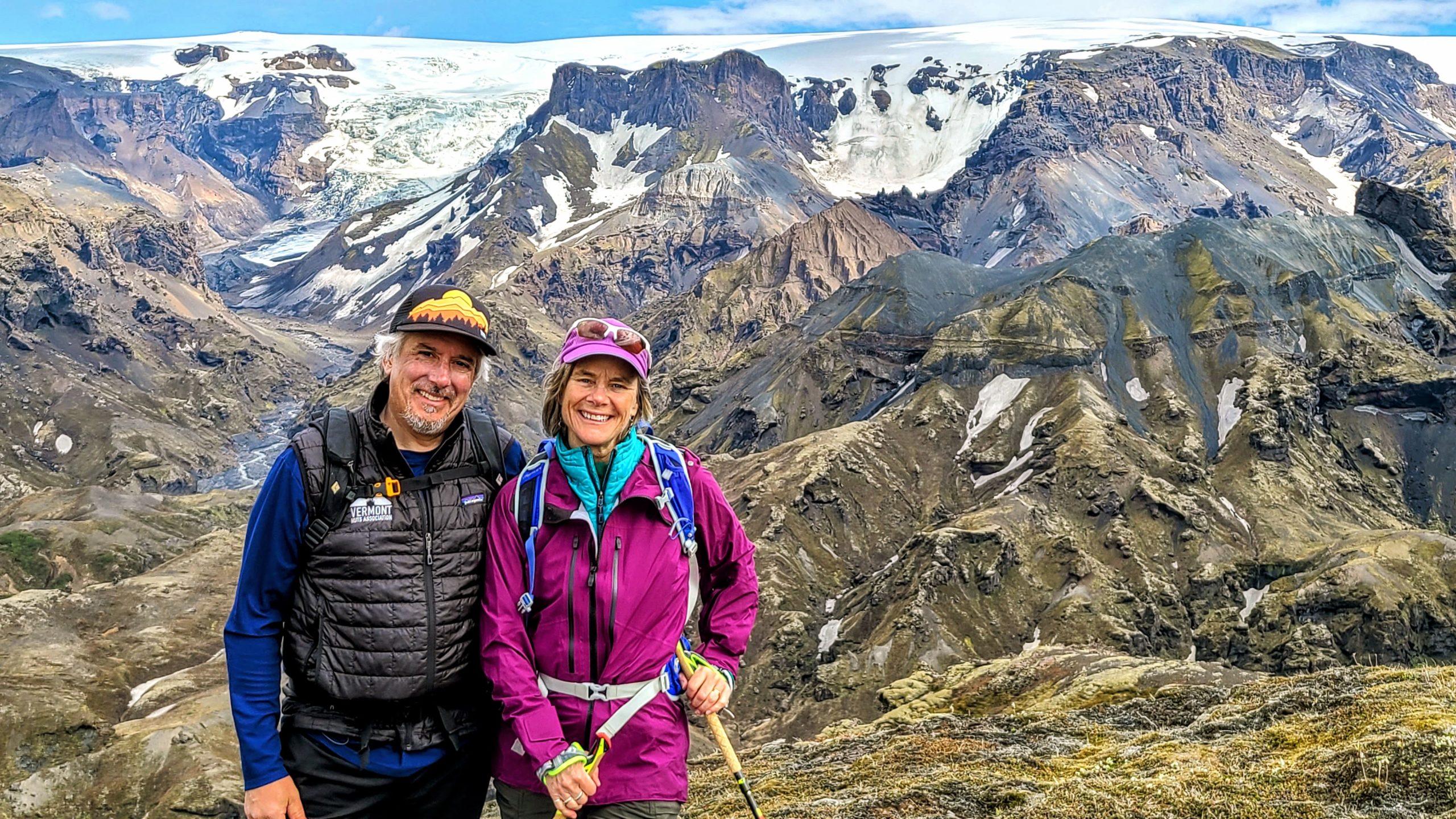
Hildur explained that melting glaciers and rising sea level could alter the Gulf Stream, which gives Iceland its unusually temperate climate and keeps temperatures similar to New York or Toronto. “Climate change is something that can risk the nature and the habitats that we live in. We might not be able to live here anymore if climate change will continue.”
Hildur has heard that a travel outfitter is offering a “last chance ice walk.” “I get goosebumps when I talk about this because I think this is so sad that my grandchildren might not be able to go on the glacier,” she continued. “The glaciers are such a huge value to us, both for the tourist industry but also just for us as people living here because we love using the glaciers to go skiing, climbing, ice walking, all of these things. It’s also the source of our water.”
It was late in the afternoon so we started back down the Fimmvörðuháls Trail to Thorsmork, a backcountry hiking hub and camping area. She abruptly changed the subject. “Are you afraid of heights?”
I replied that I was fine. Sue said nothing. Hildur offered to take her hiking poles so that Sue could more easily negotiate an exposed knife-edge ridge. Adjustment made, we all scampered across the ridge while avoiding looking at the drop below.
The land of fire and ice has a long history as a master of disaster. “The nation has grown up in this tough climate so we’re good in adapting to different kinds of circumstances. Flexibility is very strong in our culture. This is a part of our mentality: Be flexible and adapt.”
TRAVELING TO ICELAND
GETTING THERE: Icelandair offers famously cheap nonstop flights from Boston and New York to Reykjavik. A rental car is essential for getting around.
GUIDES: Hidden Iceland is a one-stop adventure consultant and guide for all things Iceland, from hiking glaciers to viewing the Northern Lights; they also design self-guided tours. Midgard Adventure offers guided hiking, SuperJeep tours into the Thorsmork area and other activities as well as hostel-style lodging.
WHERE TO STAY: In Reykjavik, we stayed at the new Reykjavik Edition Hotel next to the iconic Harpa concert hall and a short walk to the capitol’s fun nightlife. Fosshotel Nupar was a comfortable Euro-style hotel near the Vatnajokull glacier, and Umi Hotel was a convenient to everything in South Iceland. Midgard Base Camp is a friendly hostel-style lodge close to great hiking that also offers guided adventures.
OTHER THINGS TO DO: Iceland is famous for its geothermal hot springs. Sky Lagoon is a new hot spring and spa right in Reykjavik where you can soak while overlooking the ocean. The classic Blue Lagoon is touristy but beautiful. It is close to the airport and to the active Fagradalsfjall volcano, which you can hike to and watch the bubbling lava. The Golden Circle is the traditional intro to Iceland’s natural highlights. The Westman Islands is home to one of the world’s largest puffin colonies, and hiked up Eldfell, a dormant volcano that nearly obliterated the town center when it erupted in 1973.
FOR MORE INFO: Tourism: Visit Iceland, Visit South Iceland, Lonely Planet Iceland guidebook
Climate change: Government of Iceland: Climate Change, Climate Change Post: Iceland

